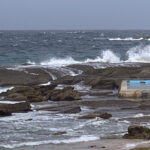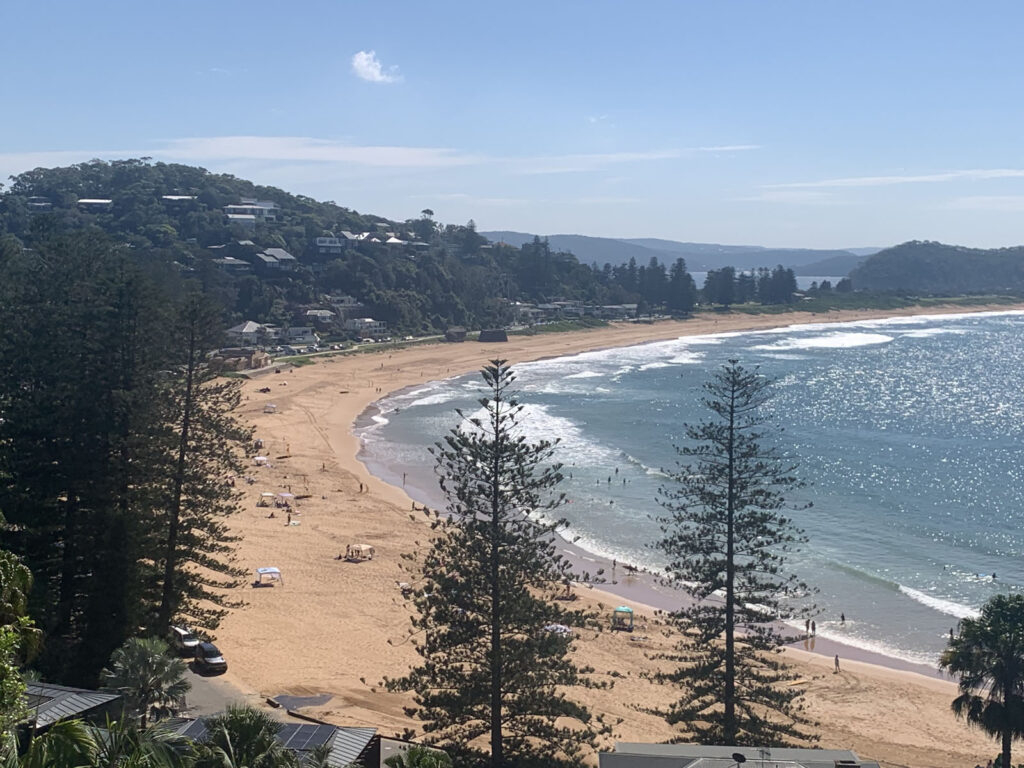
Palm Beach looking towards Barrenjoey Headland and Pittwater
CONTENTS
Planning & Development
‘The Joey’ 1191-1193 Barrenjoey Road
231 Whale Beach Road
15 Ocean Road
Traffic & Infrastructure
Meeting on site with Council Representatives
Environment
Whale Beach Clean Up Day
Palm Beach Pool Urgent Maintenance
Council
Budget Priorities
New appointments
Graffiti
Health
Northern Beaches Hospital
Staffing Cuts
New Integrated Cancer Centre, Frenchs Forest
Avalon Beach Historical Soc.
History of The Palladium
History Corner
Governor Phillip (Part 2) by Robert Mackinnon
PLANNING AND DEVELOPMENT
‘THE JOEY’ 1191-1193 Barrenjoey Road, Palm Beach MOD2023/0684
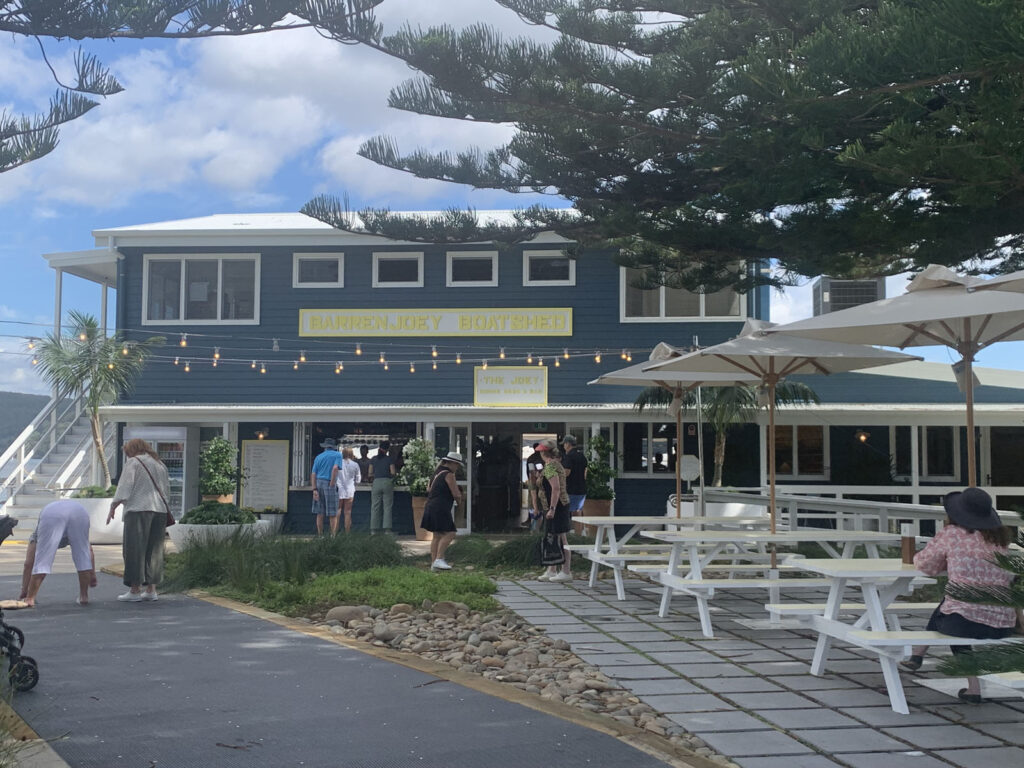
The Joey showing the public area at the front
Palm Beach has been headline news lately as a result of the application to change the hours of operation of the newly opened restaurant ‘The Joey’ (formerly The Boathouse) with even the Premier getting involved in the story. However, there has been a considerable amount of misinformation and the situation is more complicated than the simplistic story which is appearing in the press. The area on which The Joey is built is not part of Governor Phillip Park. It operates under a lease as a Crown Land which is managed on behalf of the community by the Minister for Lands and Property. The adjacent land which includes the landscaped area and carpark is part of Governor Phillip Park which Northern Beaches Council manages. However, the DA and Modifications need to be approved by the Council. The seating area at the front of the restaurant is open to the public for general use.
When the current operators of The Joey, Barrenjoey Boatshed P/L, commenced operating the restaurant the terms of their lease included the same hours of operation as had applied to the previous lessees, the Boathouse Group, with approval for 152 patrons. The hours of operation are from 7am until 4pm from Sunday to Thursday and on Friday and Saturday until 10pm from October to March. The current Modification requests an extension of the trading hours all year round from 7am to 11pm Monday to Sunday i.e. every day of the week. The application was lodged under section 4.55(1A) of the Environmental Planning and Assessment Act and this means it must have a minimal environmental impact. There have been very many submissions enthusiastically supporting and others vigorously opposing the extension to the hours. It was referred to the Council’s Development Determination Panel (DDP) but, since the Council is involved in the application as Manager of Governor Phillip Park, the application was assessed by an independent planner who recommended approval. However, a meeting was held on site with representatives of the various parties and objectors and following that the DDP refused the application.
The main objections would appear to be on the grounds of noise, the effect of extra traffic and sometimes unruly patrons on the Park and neighbourhood and the fear that it will become primarily a function centre. There is undoubtedly a demand for the reinstatement of the restaurant and it has been greatly missed while being rebuilt but there is also a large appetite for places to hold functions in Palm Beach and Whale Beach. It is, however, possible for the Council to stipulate how many functions can be held each year, which days they can be held, and also lay down the permissible noise levels, whether and when amplified sound is allowed and ways of assessing these. The Council would need to be sure that it can monitor this operation to reassure the community. Local residents could still have dinner on weekdays if the opening hours were, say, 7am to 9.30pm and also at weekends until somewhat later with functions being held on some Fridays or Saturdays. By way of comparison, The Dunes is permitted to operate during the following hours under its long-standing lease:
Kiosk/café
Summer 8am-7pm 7 days a week
Winter 8am-5pm 7 days a week
Restaurant
All year 8am-midnight Tuesday to Sunday
Since there are not many restaurants open for dinner in Palm Beach and Whale Beach and good seasonal demand it is in the interests of the community as a whole that a compromise is reached. We believe that the Council is reconsidering the matter.
231 WHALE BEACH ROAD, WHALE BEACH MOD2021/0983
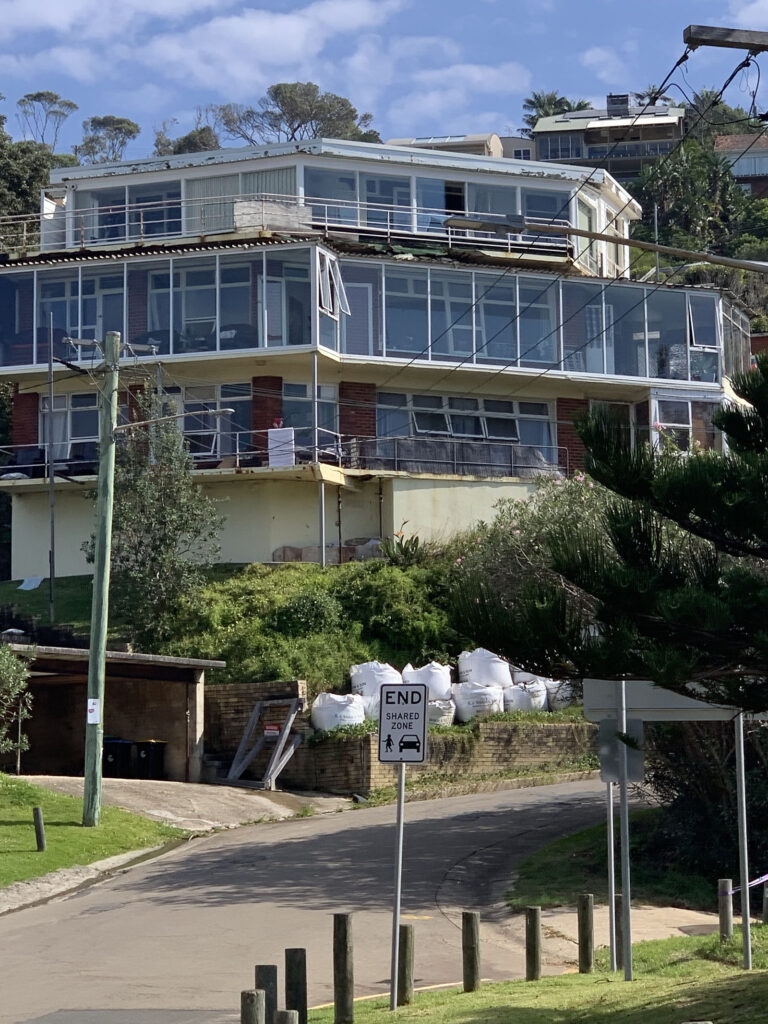
231 Whale Beach Road
Following the refusal by the Local Planning Panel of the Cassar family’s application to increase considerably the number of patrons permitted in the proposed café/restaurant, the matter was referred to the Land & Environment Court and a meeting was held on site on 19 March, 2024, at which a large number of residents, including the PBWBA, registered their opposition. However, the Council had entered into discussions to attempt to find a compromise and this compromise, referred to as the Amendment to the Modification, has now been approved by the Land & Environment Court.
The judgment sets out conditions for this approval which the Commissioner states is in line with the agreements that were reached between the experts.
The consent authorises: A mixed-use development comprising shop top housing and additional retail premises consisting of food and drink premises and shops in this E1 Local Centre Zone. Retail areas 2 and 3 which front Whale Beach Road are restricted to use as neighbourhood shops (defined as providing day-to-day needs of people who live and work in the local area). Retail area 1 on the ground floor fronting Surf Road is authorised to prepare and serve food and drink on a retail basis to be consumed either on the premises or as takeaway. The consent prohibits its use as a Function Centre which includes weddings. The hours of operation of the retail premises and restaurant or café are to be restricted to 7am to 10pm seven days per week and the external areas of the restaurant restricted to 7am to 7pm Sunday to Thursday and 7am to 9pm Friday to Saturday. All patrons are required to leave within 30 minutes. Delivery of goods and waste collection must not occur between 7pm and 7am the following day. No background music will be permitted in the ground floor café/restaurant or outdoor area and no speakers placed outside. No amplified noise is to be audible within habitable rooms of nearby residents, including when windows and doors are open.
Parking to be retained for 10 residential spaces (2 per unit), 1 disabled visitor space and 3 retail parking spaces. Capacity of the café/restaurant is as follows but this is a complex arrangement and will be difficult to enforce:
Warmer months (October to March)
Weekdays from morning-11am 150 patrons
Weekdays from 11am-5pm 150 patrons
Weekday nights from 5pm-6pm 130 patrons
Weekday nights from 6pm onwards 130 patrons
Weekends morning-11am 80 patrons
Weekends 11am-5pm 80 patrons
Weekend nights 5pm-6pm 80 patrons
Weekend nights 6pm onwards 100 patrons
Cooler months (April to September)
Weekdays from morning-11am 150 patrons
Weekdays from11am-5pm 150 patrons
Weekday nights from 5pm-6pm 150 patrons
Weekday nights from 6pm onwards 150 patrons
Weekends from morning-11am 150 patrons
Weekends from 11am-5pm 80 patrons
Weekend nights 5pm-6pm 80 patrons
Weekends nights from 6pm onwards 140 patrons
The indoor area will be limited to a maximum of 70 patrons if the eastern façade doors are open/unlocked (except in the case of emergencies). If the eastern façade doors are not open/locked, the limit is as above. On such occasions, the amenities access door shall be used to access the outdoor area (for both patrons and staff) with an automatic closing mechanism. At all times the maximum number of patrons in the outdoor area will be limited to 20 patrons. A 1.8m lapped and capped fence will have to be erected along the southern boundary between the site and 229 Whale Beach Road and a sound absorptive ceiling installed to the outdoor seating area. A Plan of Management for the site has been prepared and to promote sustainable transport for staff and patrons a Green Travel Plan must be submitted to and approved by Council before the granting of an Occupation Certificate. A link to Commissioner Horton’s decision is available on:
URL; https://www.caselaw.nsw.gov.au/decision/18ec547d27edfa1081a18e2b and the Orders under Land & Environment Court Case No 00331015
15 Ocean Road DA2023/1532
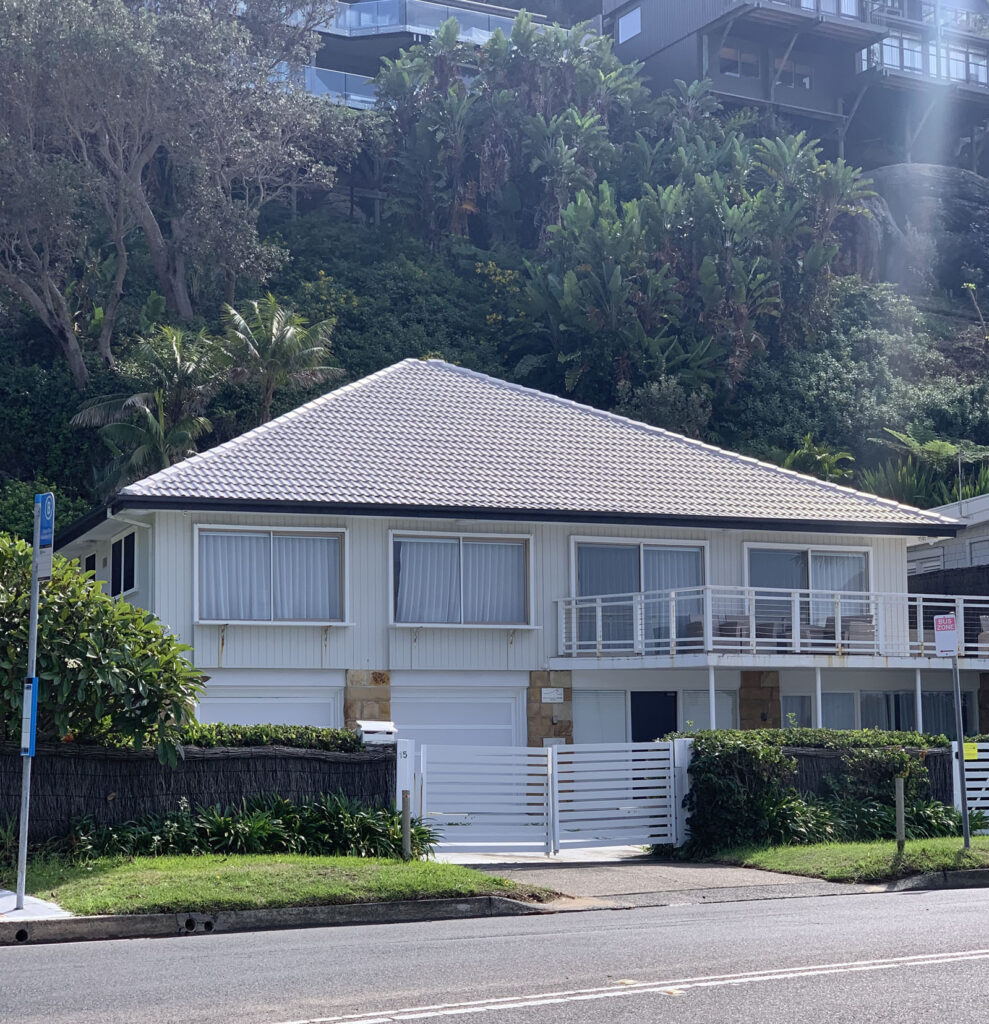
15 Ocean Road, Palm Beach
This is a development application to demolish the present house and rebuild a four storey dwelling which breaches height controls and is of unacceptable bulk and scale. It would cast major shadows over The Palladium (16 Ocean Road), one of Palm Beach’s most significant historical buildings and dwarf it. It would interfere with views from the back of The Palladium and also views from 2 Palm Beach Road, which is a heritage property. Its impact would be on the amenity of the neighbours because of its bulk and scale and the reasons advanced for breaches of planning controls under Clause 4.6 are not justified. The DA was first lodged in November 2023 and we lodged a submission highlighting the breaches of control and emphasising that the Statement of Environmental Effects (SEE) was misleading and its statements weak and unsubstantiated. Amended drawings were provided by the developer in March with the height reduced by 1.2m which is still 55.2% in excess of the height control. There is little difference to the overall bulk and scale when viewed from Ocean Road. We have also commented on the amended drawings. Both our submissions are on our website.
If you would like to make a submission or look at the detail of the development you can do so on:
https://eservices.northernbeaches.nsw.gov.au/ePlanning/live/Public/XCTrack/SearchApplications. aspx?pid=2350863
TRAFFIC AND INFRASTRUCTURE
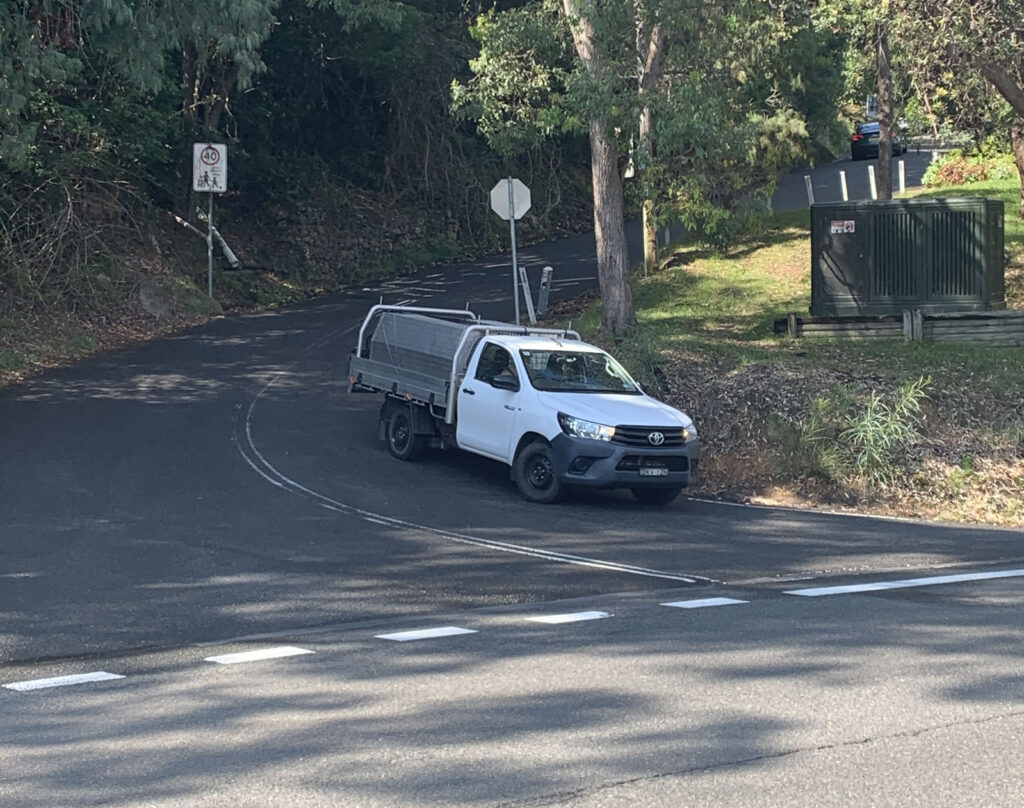
Cnr.Surf & Barrenjoey Roads
As part of the Association’s ongoing push for greater connection with Northern Beaches Council, a meeting was held just before Easter to discuss traffic, parking and infrastructure. Representing NBC were Campbell Pfeiffer (Acting Director, Transport and Assets) and Emily Carson (Acting Executive Manager, Transport and Civil Infrastructure). President Richard West, Vice-President Frank Bush and Committee Member Gordon Lang represented the residents and visitors of Palm Beach.
The meeting included a drive around the major points of interest and concern. Points highlighted included (in no particular order)
- Fire risk – Fire hydrants are often parked over. Suggestion to make them more clearly marked or no parking
- Safety on roads due to parked cars
a) Challenges with line of sight due to on-street parking, especially Palm Beach and Pacific Roads – this is critical and use of ‘line of sight’ important for safety
b) No parking yellow line on Pacific Road opposite Ralston Road – this is also critical and the use of ‘line of sight important for safety’ - Careel Bay parking: confusion with parking signage (12P 7am-7pm) . Visitors think they are unable to park for multiple days (which is promoted by NBC website)
- Surf and Barrenjoey Roads – footpath and steps due to slippery road and no safe place to walk – this is critical as there has already been one road death and many other close instances. There is also very poor vision for cars turning out of Surf Road
- Governor Phillip Park : general state of appearance, road condition, lack of toilet facilities and weeds – the overall condition of GPP is very poor (according to NBC’s own promotion, this and Barrenjoey Headland are the second most visited places within the LGA). We should be proud of it and ensure the ‘heavy users’ pay a fair cost of maintenance and improvements
- Palm Beach Pool – the pool requires work with leak getting worse and general upkeep -this is a safety issue with the broad usage of the pool
- Ocean Place – multiple accidents with buses struggling with the tight turn and footpath – Very dangerous for pedestrians.
Advocacy and involvement – the Association has been very active and diligent in our advocacy to Council with these and other issues over a number of years, with a strong focus on safety and realistic, suitable amenity. It is felt, as we take a wholistic approach and represent the residents, visitors and environment, greater involvement in the internal process would be beneficial to all. Working together should make stronger outcomes and reduce potential conflicts
Since the meeting our involvement in the planning process has been confirmed and so we are hopeful that this will prove beneficial to the eventual outcomes..
ENVIRONMENT
Whale Beach Clean Up Day
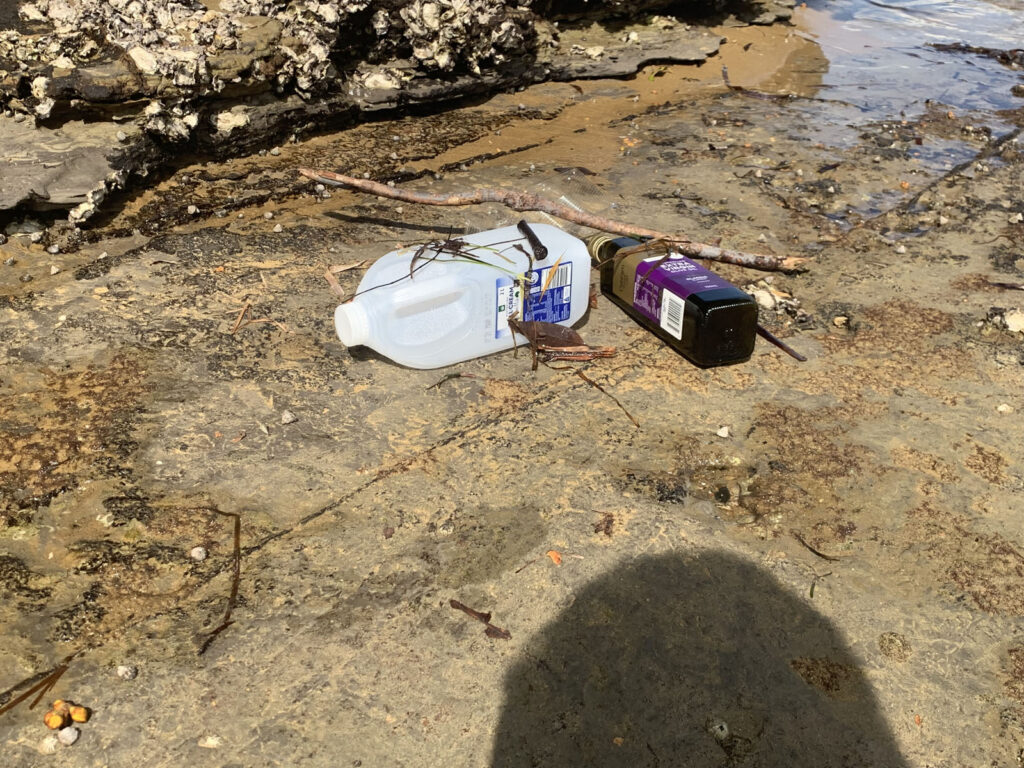 Clean up Day is Sunday 28 April at 10am. If you would like to join the Clean Up Crew please meet on the grassed area at the corner of Surf Road on The Strand. Please bring gloves, bags and buckets if you would like but they can be provided. There will be a briefing at 10am and then rubbish will be collected from the beach and surrounds until 11.15am. After bagging the rubbish those who wish can have lunch together (at your own cost). If you can only help with the rubbish collection that is perfectly OK and will be appreciated.
Clean up Day is Sunday 28 April at 10am. If you would like to join the Clean Up Crew please meet on the grassed area at the corner of Surf Road on The Strand. Please bring gloves, bags and buckets if you would like but they can be provided. There will be a briefing at 10am and then rubbish will be collected from the beach and surrounds until 11.15am. After bagging the rubbish those who wish can have lunch together (at your own cost). If you can only help with the rubbish collection that is perfectly OK and will be appreciated.
If you have any queries or need more information email:
northernbeachescleanupcrew@gmail.com
Roly’s (@ep.cleanup) coffee van will be in attendance to treat volunteers!
PALM BEACH POOL
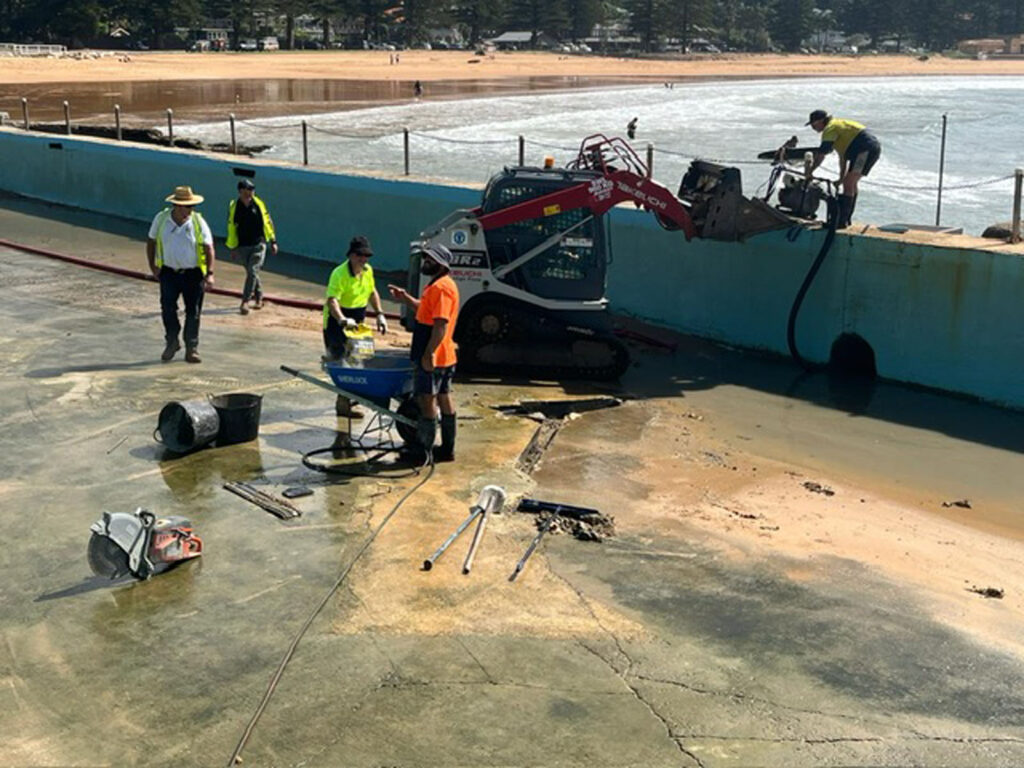
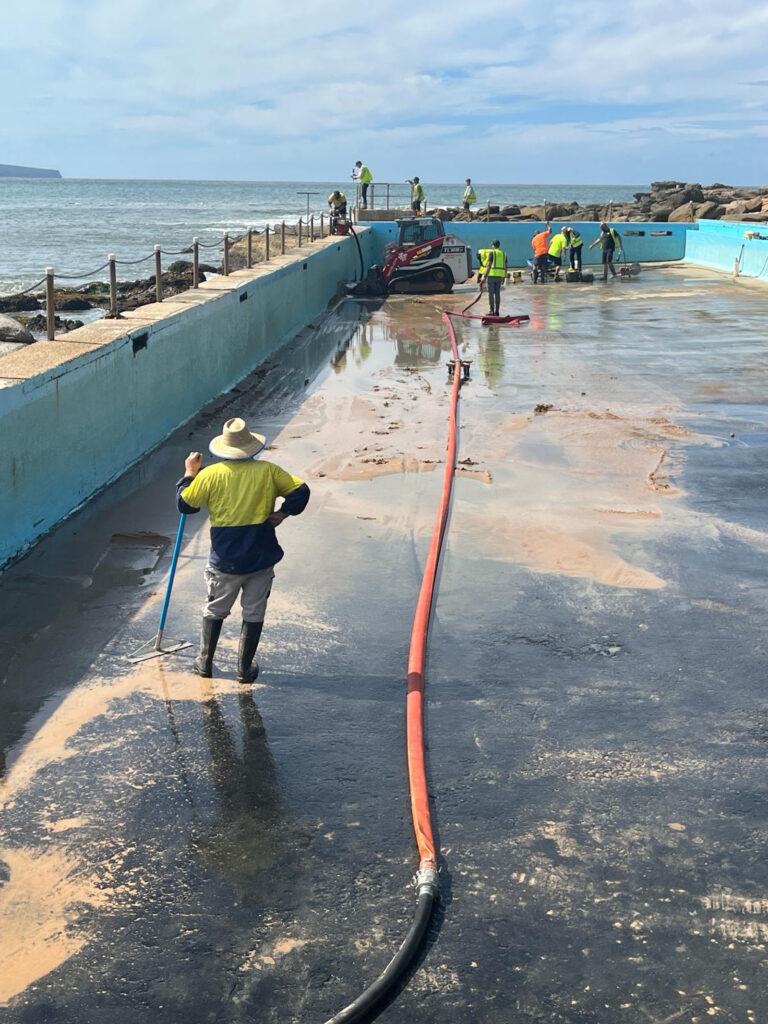 The leaks in Palm Beach Pool mean that some restoration work needed to be completed urgently because of the safety implications of a shallow water level as the water drained out.
The leaks in Palm Beach Pool mean that some restoration work needed to be completed urgently because of the safety implications of a shallow water level as the water drained out.
The Council have decided that in the short term these leaks will be repaired by filling them with concrete. A considerable capital sum , probably about $800,000, needs to be spent to do a complete restoration.
As you can see, work has started on this short term fix.
COUNCIL
Budget Priorities
The Council’s Long Term Financial Plan forms part of a Resourcing Strategy which links the Community Strategic Plan and the Council’s Delivery Program. It covers a 10 year period, currently 2018-2028. Preparation work is underway within Northern Beaches Council to prepare the Budget for next year. As we are all aware there is considerable pressure on the Council to increase maintenance and expend more capital within the LGA. The CEO recently called a Budget Strategy meeting to discuss priorities with Councillors. We have provided a list of the most pressing concerns in our area. However, the Council faces some stark choices between cutting back on expenditure, raising rates or borrowing more money. We have been warned!
New appointments
Northern Beaches Council CEO, Scott Phillips has made two new appointments, his first since joining the Council. He has appointed Campbell Pfeiffer as Director of Transport & Assets. Campbell Pfeiffer has worked at NB Council for 11 years. Kelly Loveridge is joining the Council in late June to take up the post of Chief Operating Officer responsible for two divisions – ‘Corporate and Legal’ and ‘Workforce and Technology’. She is currently Director of Corporate Services at Inner West Council. This will enable Scott Phillips to lessen the amount of operational work he does and allow him to focus more on dealing with Council matters.
Graffiti
Northern Beaches Council at its last meeting in March unanimously passed a motion put forward by Councillor Michael Gencher to create a graffiti taskforce to combat the increasing incidence of unsightly graffiti. There have been many attempts in the past to reduce the amount of graffiti such as the promotion of street art and erecting barriers in targeted areas but they have only been partly successful. Residents and business owners have complained about the damage to their property so this attempt to tackle a growing problem will be welcomed. Removal of graffiti currently costs between $500,000 and $1m. but it is only removed from Council property or public assets and is still conspicuous throughout the LGA. The motion requires the Council to draft a proposal to develop a comprehensive graffiti mitigation policy to put before Councillors within six months.
HEALTH
Northern Beaches Hospital
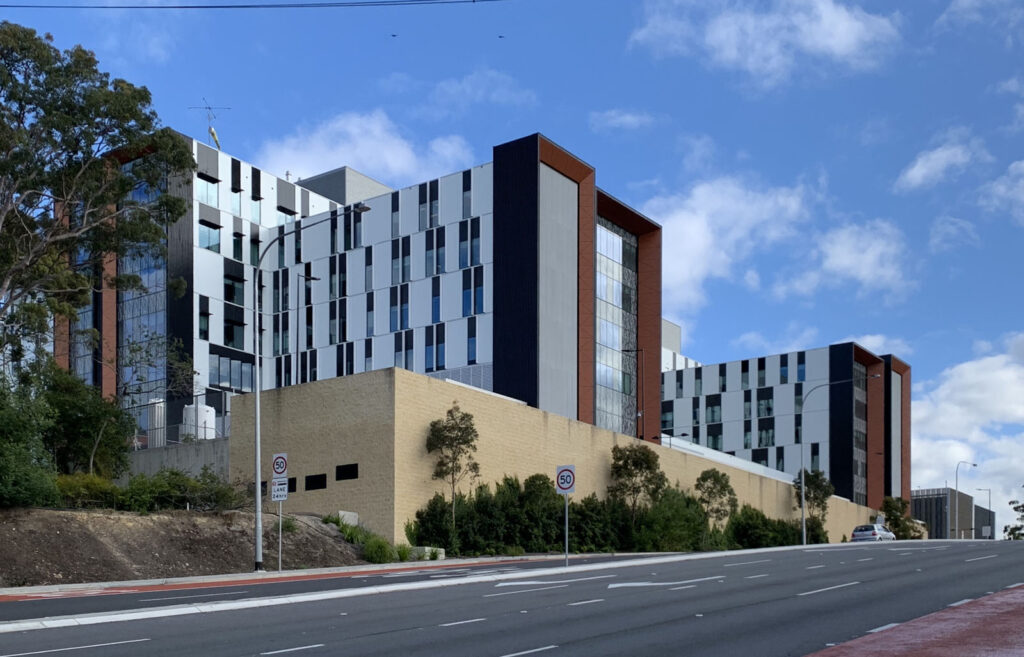
Northern Beaches Hospital
Following the State Government’s decision not to proceed with the previous government’s plan to invest $7.5m. in mental health services at Northern Beaches Hospital, there will be a reduction in the number of staff in the Mental Health and Maternity Units.
The hospital is run by Healthscope with a contract to run the public wing of the hospital until 2038. Staff have been informed that the number of full-time nurse unit managers will be halved with the remaining two managers overseeing 61 mental health beds across four specialist wards. One 12-hour day shift in the private Mental Health Unit and some shifts from the private maternity services will be cut including the ante natal liaison nurse role. Healthscope issued the following statement:
The proposed changes will in no way compromise the quality of patient care and will have a minimal impact on existing roles. Northern Beaches Hospital’s child and adolescent mental health services will not be affected by the proposed changes.
The Chief Executive, Andrew Norton, has announced his resignation this month after four and a half years in the job, and will become the CEO of Wentwest which is a federal government funded primary health care organisation supporting health professionals. It is located in Westmead Health Precinct. A search is underway for his replacement at Northern Beaches Hospital.
Healthscope is currently undertaking a restructure of $1.6bn. of debt and will attempt to address falling revenues by charging private health insurers more. In 2019 it was acquired by Brookfield a Canadian private equity company.
New Integrated Cancer Centre, Frenchs Forest
GenesisCare have opened a comprehensive cancer facility at Frenchs Forest. It will enable cancer patients to access all their care including radiation therapy, chemotherapy, haematology and immunotherapy. Pathology services will be provided by NSW Health Pathology and diagnostic imaging equipment will also be installed. Cancer surgery will still need to be performed in hospital. GenesisCare now operates 49 centres in Australia with 12 in NSW and overseas in USA, UK and Spain. The Centre Leader in Frenchs Forest is Kerryn Miller. Around 1,700 people were diagnosed with cancer on the Northern Beaches in 2021. The full range of non-operative care will be provided in a new building – Building 9, 49 Frenchs Forest Road East, Frenchs Forest. GenesisCare was founded in Brisbane in 2005. It offers both public and private services.
More information is available on the Genesis website: https://genesiscare.com/au/our-centres/frenchsforest
AVALON BEACH HISTORICAL SOCIETY
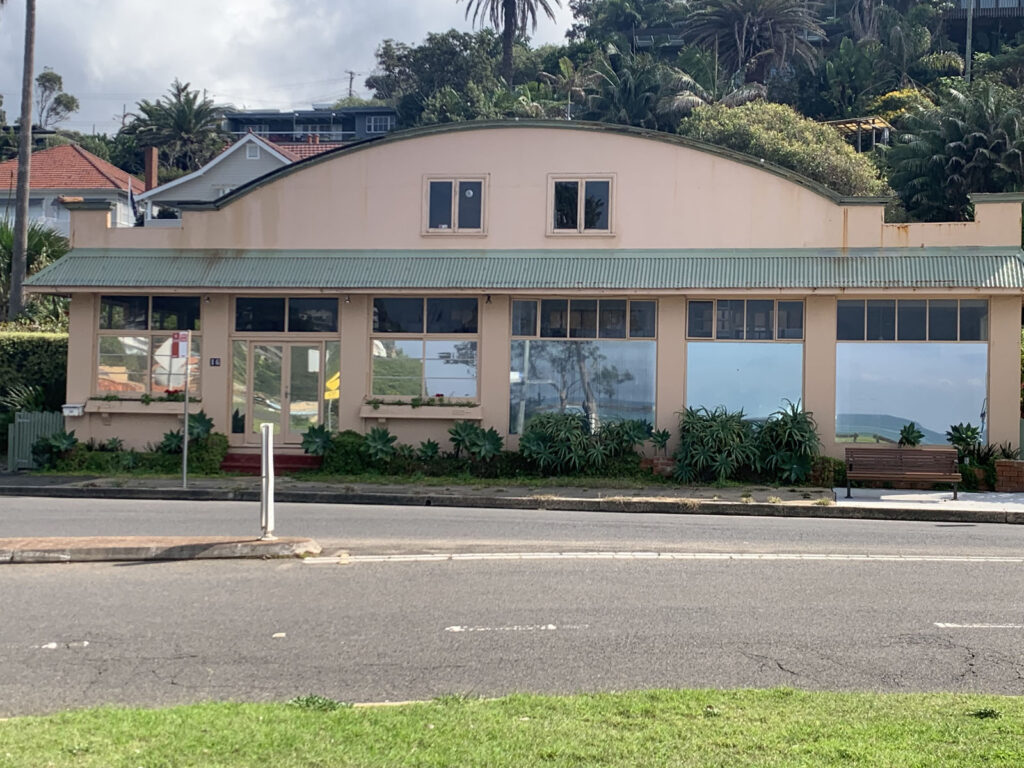
The Palladium Ocean Road Palm Beach
At its first meeting of the year Avalon Beach Historical Society had a bumper crowd in the Annexe in Dunbar Park to hear David Elfick talk about his property, The Palladium, in Ocean Road which he has owned and lived in for 50 years. It has a fascinating history and this was also demonstrated by photos from Geoff Searl’s collection. We are hoping that they will repeat this talk for PBWBA members as it is an important piece of Palm Beach history we need to know more about.
HISTORY CORNER BY ROBERT MACKINNON
GOVERNOR ARTHUR PHILLIP (PART 2)
Two kidnappings, a spearing, then at last some progress – Governor Phillip’s dealings with Sydney’s indigenous people
In the previous instalment, we examined the extraordinary life Arthur Phillip led before he was selected as Commander of the First Fleet. With his character forged through many experiences, Phillip rose above his modest beginnings, working first on a whaling ship in the Arctic Circle, engaging in battles at sea in the Americas, carrying out espionage in France and enduring a failed marriage. But nothing prepared him for the challenges he faced in dealing with Australia’s indigenous people.
Phillip had unambiguous instructions about his role in the new colony. Dated 25th April 1787 and signed by King George III, Phillip’s commission included these words:
‘You are to endeavour by every possible means to open an Intercourse with the Natives and to conciliate their affections, enjoining all Our Subjects to live in amity and kindness with them.’
A well-intentioned man, ingrained in naval tradition and culture, Phillip took his commission seriously. In the language of today, Phillip’s habit was to lead from the front, something he did on his very first encounter with the natives of Botany Bay. Showing them his musket, he laid it on the ground and approached a group of them with open arms. As reported by George Worgan, one of the Assistant Surgeons on the First Fleet:
‘…one of the oldest of the Natives gave his spears to a younger, and approached to meet the Governor’.
For a time, the goodwill shown toward the natives by Phillip and his men was reciprocated; gifts were exchanged, pleasant words uttered and the natives were often helpful in assisting the newcomers who seemed so wrong-footed in adapting to their new environment. But before long it became clear to indigenous Australians that these recently landed people, with their ghostly white faces, unlike previous visitors such as James Cook, Abel Janszoon Tasman or Marc-Joseph Dufresne – respectively British, Dutch and French explorers – showed no intention of leaving.
Despite Phillip’s resolve to fulfil his commission, shortly after the colonists arrived, infractions began. Opportunists raided Aboriginal camps for artefacts and found a ready market in the visiting sailors who stood to make handsome profits from their sale. Fleeing convicts trespassed on sacred sites and burial grounds, large-scale land clearing decimated foraging places, and animals, such as wallabies, sought refuge further afield, far from their usual feeding grounds. For a people closely attuned to nature, who used resources only when needed, undoubtedly the natives were aghast at the settlers’ profligacy such as when a massive haul of fish was netted in December 1790. In the words of Judge Advocate David Collins:
‘The day preceding the governor’s visit [to Manly Cove], the fishing boats had the greatest success which had yet been met with; near four thousand of a fish, named by us, from its shape only, the salmon, being taken at two hauls of the seine [nets]. Each fish weighed on an average about five pounds…’
Aboriginal tensions simmered throughout 1788 as they lashed out at settlers, behaviour that might be expected of a people who enacted justice through retribution or payback. During that first year, at least twelve white people, convicts and settlers alike, were either killed or had disappeared, with another seven wounded. However, there is no record of what happened to them. And the settlers were far from blameless, resorting at times to their muskets.
Phillip was determined to avoid using arms against the natives and made his point clearly in a letter to the Marquis of Landsdowne dated 3rd July 1788, which perhaps in typical British fashion for the time found fault with the French:
‘It has been my determination from the time I landed, never to fire on the Natives, but in a case of absolute necessity, & I have been so fortunate as to have avoided it hitherto. I think they deserve a better Character than what they will receive from Monsr. La Perouse, who was under the disagreable necessity of firing on them.’
As 1788 drew on, it became clear to the settlers that indigenous people had little interest in engaging with them. Moreover, Aboriginal people were quick to attack any white men who weren’t travelling in a group and thought nothing of stealing settler’s implements and livestock. Their errant behaviour brought these words from Lieutenant William Bradley penned on 1st October:
‘What has been experienced lately in several instances of meeting with the natives, has occasioned me to alter those very favourable opinions I had formed of them…’
Bradley went on to write:
‘Latterly they have attacked almost every person who has met with them that has not had a musquet and have sometimes endeavoured to surprise some who had.’
In a sign of restraint, records from 1788 show that just three indigenous people were injured that year. But Phillip was getting nowhere in establishing a working relationship with Aboriginal people. As 1788 drew to a close, it was abundantly clear to him that there was little chance of reaching any kind of detente with the natives let alone finding a leader among them, an ambassador of sorts, with whom he could form an alliance. Captain John Hunter, who later became Governor, wrote of Phillip’s frustration:
‘…the governor having found that no encouragement he could give the natives, would dispose them to visit the settlement of their own accord…’
Desperate, Phillip decided his best option would be to kidnap two men, treat them well and teach them English, hoping his peaceful intentions would be clear. It’s also believed he was hoping to learn more about native food sources as the colony’s crops were not doing well and food supplies were dwindling. He put his plan into effect at Manly Cove (Kai’ymay) on December 30th 1788. Two men were captured, lured by gifts, and taken aboard the Governor’s vessel. One escaped, but not the other.
Hunter described what transpired:
‘…one of the seamen, who had been previously directed, threw a rope round his [the native’s] neck, and dragged him in a moment down to the boat; his cries brought a number of his friends into the skirts of the wood, from whence they threw many lances, but without effect. The terror this poor wretch suffered, can better be conceived than expressed…’
The captive was bundled into the bottom of the boat and upon arriving at Government House was scrubbed clean and dressed in British clothes. Phillip called him Manly, but later used his native name, which was Arabanoo. Shackled at first, but soon proven trustworthy enough to be freed, Arabanoo, though a warrior, was reserved by nature and carried a quiet pride. A gentle man, Arabanoo showed a fondness for children. And when the smallpox epidemic spread through the colony in 1789, he tended those of his people, especially children, who sought treatment. Unfortunately, like many others, he succumbed to the disease. He died in May 1789 and was buried in the Governor’s garden.
We can thank Arabanoo for the naming of Manly, part of Gayamaygal country. Urban mythology has it that Phillip named Manly for the stature of the Aboriginal men who lived there. And as often happens, it’s a story that has been repeated in books and articles in newspapers and periodicals. In fact, Phillip used the term specifically for Arabanoo. But after a time, through popular usage his place of origin became known to the colonists Manly Cove. Incidentally, Arabanoo’s name lives on with a lookout of that name at Dobroyd Point, near Manly, and an Arabanoo Street Seaforth.
With Arabanoo’s passing, there were no Aboriginal guests or visitors at Government House. Through the remainder of 1789, hostilities between black and white continued, constant reminders to Phillip about his lack of progress in dealing with the natives. Action was needed. And on 25th November that year, once again under Phillip’s orders, marines abducted another two native men from Manly Cove. This time, the task went to William Bradley who described it in these words:
‘It was by far the most unpleasant service I was ever ordered to Execute…all that could be said or done was not sufficient to remove the pang they naturally felt at being torn away from their friends; or to reconcile them to their situation.’
Using the lure of two fish held up from their captor’s boat, two men from a large group of dancing natives, were enticed over and captured. They were Colebee (Coleby) and Woollarawarre Bennelong. Both men bore the facial markings left by smallpox. And neither were from the Gayamaygal clan that resided in the area. Colebee, who was about 35, was a Cadigal man from the clan that frequented the area we know today as Sydney and the Eastern Suburbs. And Bennelong, who was around 25, was a Wangal man from south of the Parramatta River.
Within a week, Colebee escaped, having pulled his rope from a shackle. Five months later, Bennelong, by then was a trusted person at Government House, did the same. Thus for a second time, Phillip’s attempts at kidnapping and amity with representatives of the Aboriginal people, had failed.
But something changed. An inflection point in black and white relations occurred after Phillip was speared at Manly Cove on 7th September 1790. He’d responded to a message from Bennelong to meet him at a gathering of indigenous people feasting on the carcass of a whale, an Aboriginal delicacy. Phillip’s injury appeared to be life threatening, the long spear passing through his shoulder. But under the care of Assistant-Surgeon William Balmain, the wound was declared non-fatal, and after ten days Phillip was able to visit Bennelong at his camp on the north shore. There, Bennelong assured him that the spearing was unplanned and that he and Colebee had beaten the perpetrator, who had acted out of fear. However, respected historians such as the late Inga Clendinnen believe that Bennelong had planned the whole affair, the spearing a form of payback on behalf of the entire indigenous population.
Strange as it may seem, this event cleared the air between Bennelong and Phillip. Bennelong had broken the ice; it was now up to Phillip to respond. And he did, in kind. According to Clendinnen, a few days after the spearing, having had a particularly good catch of salmon, Phillip made sure ‘thirty or forty fish’ went to Bennelong and his people. Later, Bennelong was provided with beef, bread and wine, which he ate with gusto before allowing himself to be shaved by the British, a gesture of trust that alarmed his followers. Subsequently, Bennelong and his party visited Government House on 8th October. And thereafter, Bennelong, his wife Barangaroo and many others, barely clad, made Government House their own as per this account written by Captain John Hunter scarcely six weeks after Phillip’s spearing:
‘Early in the morning of the 13th of November [1790], sixteen of the natives visited the settlement, and some fish being distributed amongst them, they made a fire in the governor’s yard, and sat down to breakfast in great good humour…’
That same month, Phillip had a brick and tile hut built as Bennelong’s residence at the site of the Sydney Opera House, now known of course as Bennelong Point. A genuinely strong bond seemed to develop between the Governor and his captive: Bennelong called Phillip Beanga, meaning father, and Phillip reciprocated by calling Bennelong Doorow, or son.
But Phillip was unwell. Since his first foray into Broken Bay in March 1788, Phillip had experienced pains in his side, a condition endured by him in his usual steadfast manner. However, as his ailment worsened over succeeding years, he was in need of specialist medical care and in December 1792 sailed for England on board HMS Atlantic. Accompanying him was Bennelong and a young Aboriginal man Yemmerrawanne. Like Bennelong, Yemmerrawanne was a Wangal man. He was probably chosen for the voyage because he’d become something of a fixture at Government House. Watkin Tench described him as ‘a slender fine looking youth…about sixteen years old’ with a ‘countenance which carried in it every mark of youth and good nature’ adding that this ‘good-tempered lively lad, was become (sic) a great favourite with us.’ Phillip’s motivation in taking the two men to England can be gauged in a letter he wrote to Joseph Banks in 1791 in which he mentioned Bennelong’s intelligence and the prospect of Banks obtaining ‘much information’ from him.
Whilst in London, among other activities, Bennelong and Yemmerrawanne visited the theatre and attended debates in the House of Commons. But despite many popular accounts to the contrary, they didn’t have an audience with the King though it’s possible they might have sighted him at one of the theatre performances they attended.
During their stay, the teenaged Yemmerrawanne suffered from an illness that lingered for over five months. Various remedies were tried but on 18th May 1794 he died, the first Aboriginal person to do so in England. A funeral for him was held at Eltham Parish Church, where Governor Phillip saw to it that the Crown provided a tombstone. As for Bennelong, he remained abroad, returning in September 1795, a stay of almost three years. But as the historian Keith Vincent Smith points out he spent eighteen months ‘…on board ships, either at sea or in the docks.
A little known legacy of Bennelong’s time in London is recorded in a musical score, a permanent reminder of a recital given by Bennelong and Yemmerrawanne in 1793. No doubt feeling constricted by the fashionable Regency clothing they wore, the two men performed the song whilst using clapsticks to maintain the rhythm. Whilst no details are given, it is probable that they sat on the floor in traditional manner as the notes provided with the score reveal that ‘the left hand stick rested on the ground, while the other by the right hand was used to beat against it.’ Beginning with the words ‘Barrabu-la Barra-ma’ it was said to be a song ‘in praise of their lovers’, the melody and lyrics documented by Edward Jones, a Welsh harpist, who called it ‘A Song of the Natives of New South Wales’.
Phillip’s success in dealing with the Aboriginal people of New South Wales was mixed. But in the end, he established a firm relationship with Bennelong and Barrangaroo, people who are now part of our national story. Despite the kidnappings, overall Phillip’s approach was humane and well-considered, an object lesson for future Governors.
FORTHCOMING EVENTS
Big Ideas Forum Wed 1 May 7-8.30pm Glen Street Theatre
This will be a thought-provoking discussion with Hugh Mackay, the best selling author and social researcher. He will discuss his latest book The Way We Are: Lessons from a Lifetime of Listening and the major trends shaking the foundations of the Australian way of life. We are encouraged to reflect deeply on the question: What kind of society do we want to become?
Glen Street Theatre’s bar will be open following the event with light catering provided.
Ticket costs:
Adult $10
Concession $5
Book at glenstreet.com.au
ANZAC Day
Whale Beach Surf Life Saving Club and Palm Beach RSL Sub Branch invite you to join them for the 2024 Anzac Day Dawn Service at 6 am on Thursday 25 April at Whale Beach. At 10.45am the Parade will be from Iluka Wine Store to Palm Beach RSL followed at 11am by the Service at Club Palm Beach RSL. Two Up all afternoon at the RSL in the spare block next to the Kayak Shed. Entry through the Club on Barrenjoey Road.
Next Coffee Morning
Monday 29 April, 10.30 am at Pacific Club
Next Committee Meeting
Monday 13 May, 7 pm at Pacific Club
AGM
Tuesday 14 May, 7 pm at Pacific Club
Christmas Party
Sunday 8 December, at Dunes, Gov Phillip Park
Please do not hesitate to contact PBWBA with any questions, concerns or thoughts.
Email: info@pbwba.org.au
Prof Richard West AM
0407 942 941

